Crochet basic stitches are the foundation of this craft. Learning them opens doors to countless projects. With clear guides and step-by-step tutorials, beginners can master these essentials easily.
1.1. Importance of Learning Basic Crochet Stitches
Learning basic crochet stitches is essential for building a strong foundation in the craft. These stitches are the building blocks for all crochet projects, allowing creativity and versatility. By mastering them, you can progress to more complex patterns and designs.
Understanding basic stitches also helps in reading patterns and troubleshooting common mistakes. Resources like PDF guides and step-by-step tutorials provide clear instructions, making it easier for beginners to grasp these fundamentals. Starting with the basics ensures a smooth learning journey and opens the door to endless possibilities in crochet.
(Word count: 122)
1.2. Essential Resources for Beginners (Including PDF Guides)
For beginners, having the right resources is crucial. PDF guides, such as the “Crochet Made Easy” book, offer step-by-step instructions and clear diagrams to learn basic stitches. These guides are perfect for visual learners, providing detailed illustrations of stitches like the chain, single crochet, and half-double crochet.
Additionally, websites like Bella Coco Crochet and Pocket Yarnlings provide free PDF tutorials and stitch libraries. These resources often include video links and photo tutorials, making it easier to grasp techniques. Many platforms also offer free crochet stitch libraries with 30 or more stitches, catering to both beginners and intermediate learners. Paid resources, such as comprehensive stitch books, are also available for those seeking in-depth guidance. These tools ensure a smooth learning journey, helping beginners master the basics and beyond.
(Word count: 122)
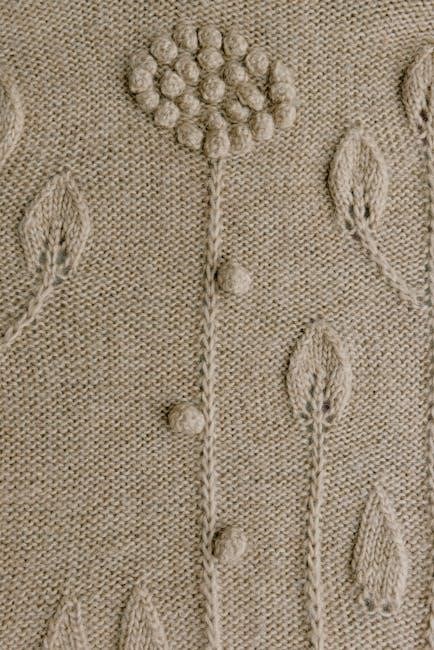
Materials and Tools Needed for Crochet
Essential crochet materials include hooks (aluminum, steel, plastic) and yarn (cotton, acrylic, wool). Hooks vary in size; yarn comes in different fibers and weights for versatile projects.
2.1. Choosing the Right Crochet Hook
Selecting the right crochet hook is crucial for achieving the desired fabric. Hooks come in various materials like aluminum, steel, or plastic, each offering different benefits. Aluminum hooks are durable and provide good stitch definition, while steel hooks are ideal for fine yarns. Plastic hooks are lightweight and comfortable for long sessions. Hook sizes are standardized, ranging from small (B/1) to large (N/13). Choose a hook size that matches your yarn weight for proper tension. Beginners often start with aluminum hooks for versatility. Consider the handle comfort, as ergonomic grips reduce fatigue. Having multiple hook sizes ensures flexibility for different projects. Always refer to patterns for recommended hook sizes to ensure your stitches align with the design;
2.2. Selecting the Appropriate Yarn
Selecting the right yarn is essential for your crochet project’s success. Yarns vary in weight, fiber, and texture, each suitable for different outcomes. Choose yarns that match your pattern’s recommendations to ensure proper stitch definition and drape. Acrylic yarns are soft, durable, and affordable, making them ideal for beginners. Cotton yarns are breathable and great for summer projects, while wool yarns offer warmth and are perfect for winter items. Consider the care instructions, as some yarns require handwashing. Always check the yarn weight on the label, as it ranges from superfine to bulky. Starting with a medium-weight yarn is best for learning basic stitches. Experiment with colors to add personality to your projects, but ensure the yarn’s texture complements the stitch pattern.
2.3. Additional Tools for Crochet
Beyond the hook and yarn, several tools enhance your crocheting experience. A tapestry needle is indispensable for weaving in ends neatly. Scissors are essential for cutting yarn, while stitch markers help track patterns and prevent mistakes. Measuring tape or rulers ensure your work meets size requirements. Stitch counters or apps can monitor progress, especially for complex patterns. Yarn bowls keep yarn organized, preventing tangles. Crochet stitch guides or gauges help maintain consistency, and small accessories like stitch holders or cable needles aid in intricate designs. Optional tools like ergonomic grips for hooks or crochet lights improve comfort and visibility. These tools streamline the process, making crocheting more efficient and enjoyable for beginners and experienced crafters alike. Investing in quality tools supports better results and overall satisfaction.
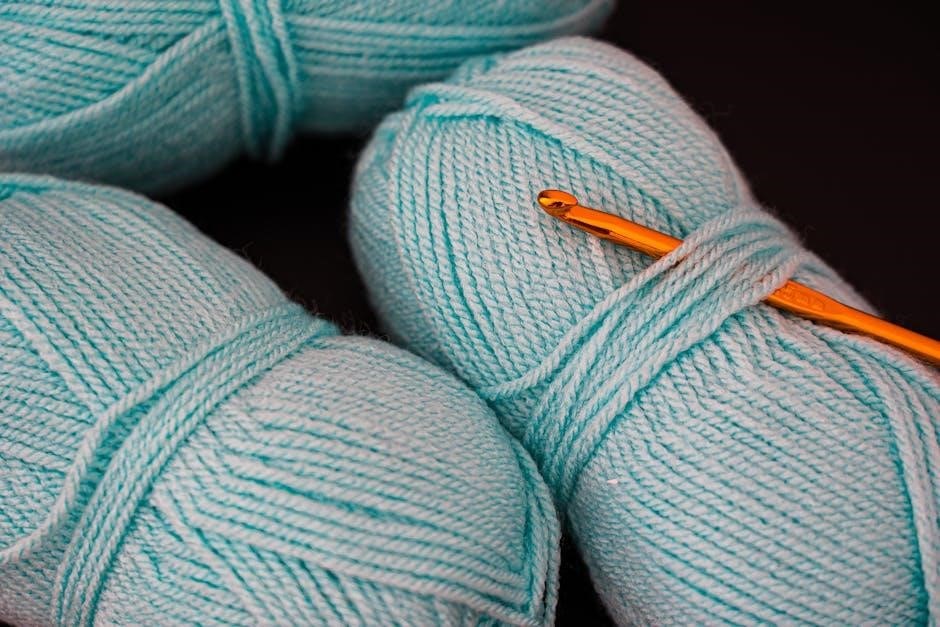
Fundamental Crochet Stitches
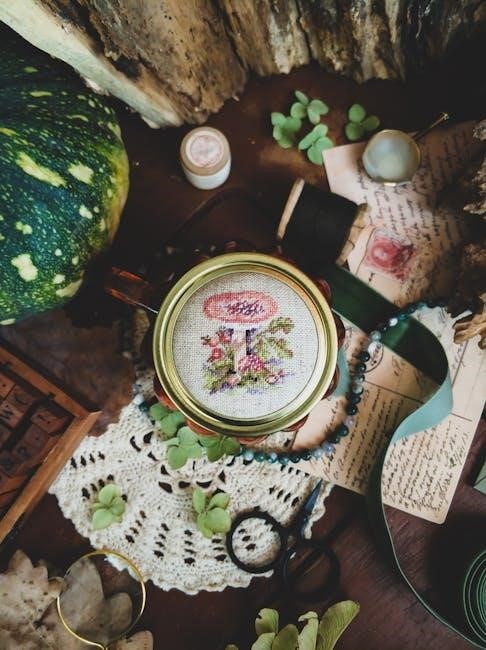
Mastering basic stitches like chain, single crochet, half-double, double, and slip stitch forms the foundation of crochet. These stitches are essential for creating various patterns and designs.
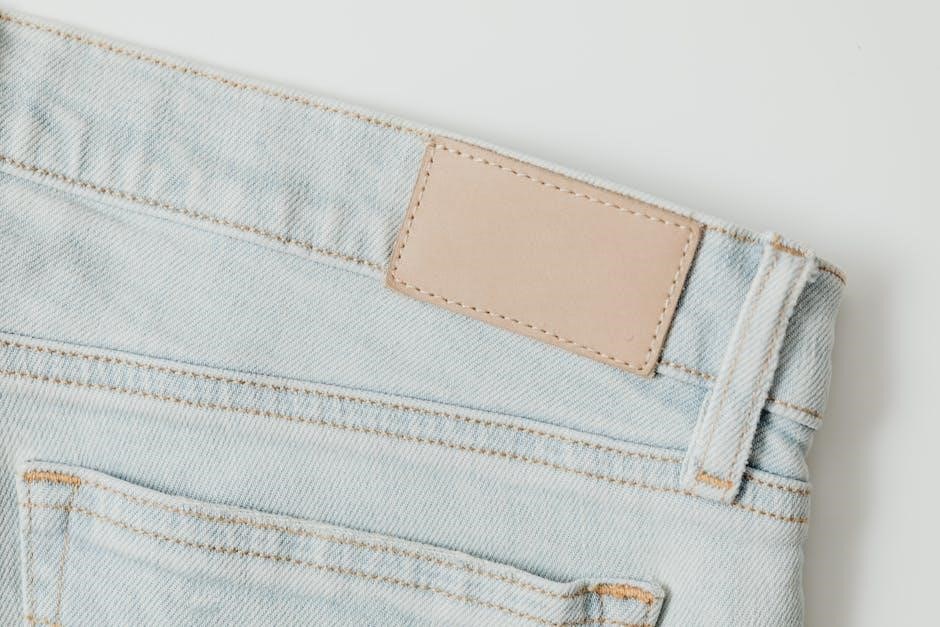
3.1. Chain Stitch (Ch)
The chain stitch is the most basic and essential stitch in crochet, serving as the foundation for most projects. It is created by yarning over and pulling the yarn through the stitch on the hook. To start, make a slip knot on the hook, then insert the hook into the stitch, yarn over, and pull through. This stitch is used to create the starting edge of a project or to join rounds in a circular project. Practice the chain stitch to ensure even tension, as it sets the stage for all other stitches. Many crochet basic stitches PDF guides include detailed step-by-step instructions and visuals to help master this fundamental technique;
3.2. Single Crochet (SC)
The single crochet (SC) is one of the most common stitches in crochet, creating a soft, fabric-like texture. To work an SC, insert the crochet hook into the stitch indicated in your pattern or the next available stitch. Yarn over, then pull up a loop, creating two loops on the hook. Yarn over again, and pull through both loops to complete the stitch. The SC is a versatile stitch used in countless patterns, from scarves to blankets. It’s essential for beginners to master, as it builds on the chain stitch and is often used in combination with other stitches. Many crochet basic stitches PDF guides include detailed instructions and photos to help learners perfect the SC stitch, ensuring a smooth transition to more complex patterns.
3.3. Half-Double Crochet (HDC)
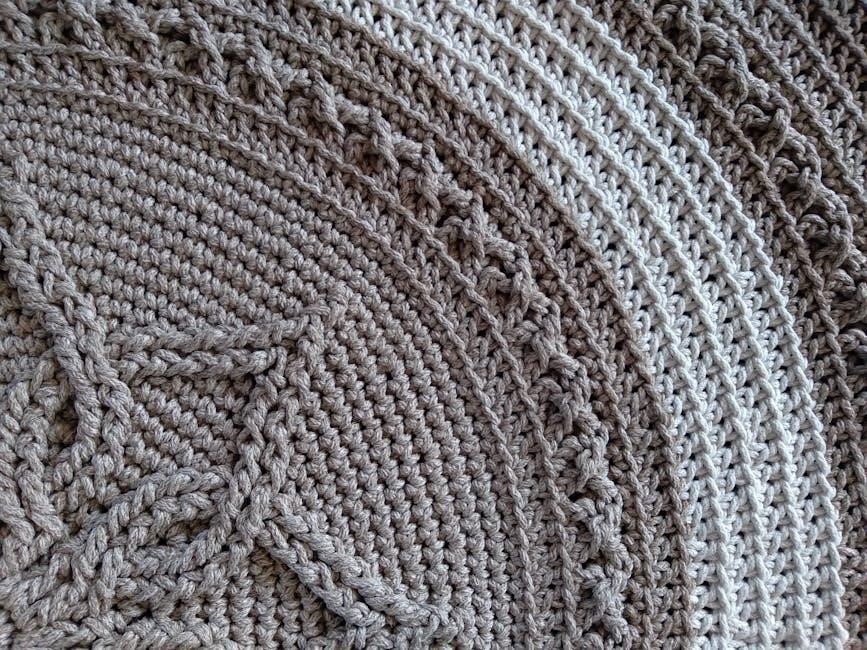
The half-double crochet (HDC) is a versatile stitch that creates a fabric with a slightly taller texture than the single crochet. To work an HDC, yarn over, insert the hook into the stitch indicated, yarn over again, and pull up a loop (two loops on the hook). Yarn over one more time and pull through both loops to complete the stitch. The HDC is a popular choice for garments, blankets, and home decor items due to its smooth, flexible texture. It’s often used in patterns that require drape and comfort. Many crochet basic stitches PDF guides include step-by-step photos and tutorials for mastering the HDC, making it easier for beginners to learn and incorporate into their projects. Proper tension is key for a consistent fabric.
3.4. Double Crochet (DC)
The double crochet (DC) is a popular stitch that creates a tall, open fabric. It is worked by yarning over, inserting the hook into the stitch, yarning over again, and pulling up a loop (two loops on the hook). Yarn over one more time and pull through both loops to complete the stitch. The DC is widely used in afghans, sweaters, and home decor items due to its quick-to-work and visually appealing texture. It is slightly taller than the half-double crochet, offering more drape and flexibility. Many crochet basic stitches PDF guides include tutorials for the DC, making it accessible for beginners. Proper tension is crucial to ensure even stitching and a professional finish. The DC is a foundational stitch that opens the door to more complex patterns and designs.
3.5. Slip Stitch (Sl St)
The slip stitch (Sl St) is a versatile and essential stitch used to join two pieces of crochet work or to fasten off a project. It is worked by inserting the crochet hook into the designated stitch, yarning over, and pulling the yarn through both the stitch and the loop on the hook. The slip stitch is nearly invisible, making it ideal for sewing seams or connecting rounds in a project. Unlike other stitches, the slip stitch does not add height to the fabric and is not counted as a stitch in the final product. Many crochet basic stitches PDF guides include this stitch, as it is a fundamental skill for completing and finishing projects neatly. Practicing even tension ensures the stitch lies flat and does not pucker the fabric.
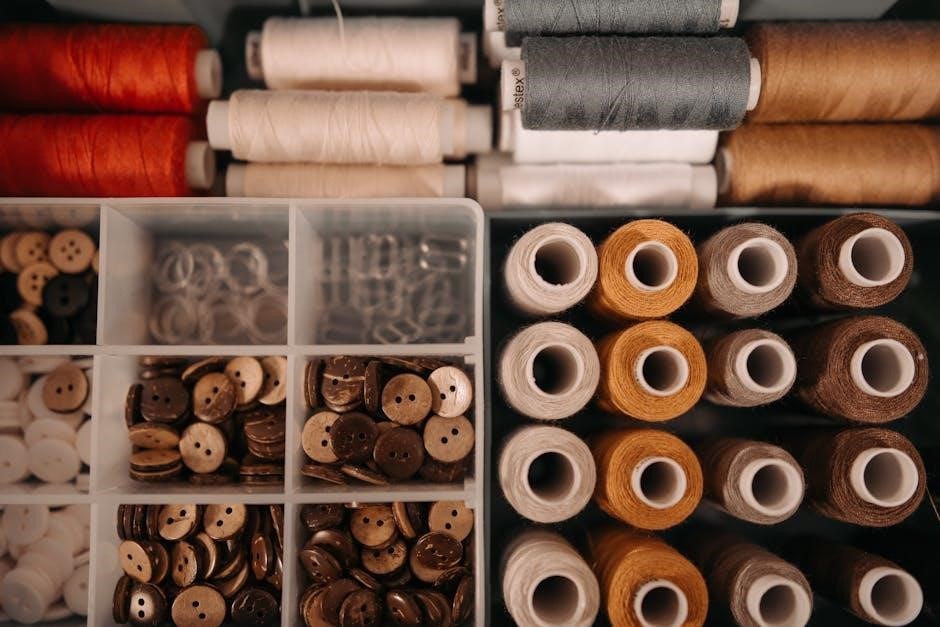
Understanding Crochet Patterns and Abbreviations
Mastery of crochet patterns and abbreviations is key to successful projects. Patterns use symbols, charts, and shorthand to guide stitch placement and repetition. Many crochet basic stitches PDF guides offer detailed explanations to help beginners decode these elements, ensuring clarity and accuracy in their work.
4.1. Common Crochet Abbreviations
Mastering common crochet abbreviations is essential for reading patterns effectively. Abbreviations like Ch (chain), Sc (single crochet), HDC (half-double crochet), DC (double crochet), and Sl St (slip stitch) are frequently used. These shorthand terms help keep patterns concise and easy to follow. Many crochet basic stitches PDF guides include a glossary of abbreviations to ensure clarity. Understanding these symbols is crucial for executing stitches correctly and maintaining the intended design. Beginners should familiarize themselves with these abbreviations early on, as they form the foundation of all crochet patterns. Keeping a reference list or cheat sheet handy can be incredibly helpful while learning.
4.2. Reading Crochet Patterns
Reading crochet patterns requires attention to detail and understanding of the structure. Patterns typically include materials needed, gauge, and step-by-step instructions. Abbreviations are commonly used, so referencing a guide is essential. Patterns may specify the number of stitches, rows, or rounds, and often include tips for customization. Beginners should start with simple patterns labeled as “easy” or “beginner-friendly.” Paying attention to the gauge ensures the finished project will fit as intended. It’s important to read through the entire pattern before starting to understand the flow. Breaking down complex patterns into smaller sections can make them less overwhelming. Highlighting or underlining key steps can also help with clarity. Practice and patience are key to mastering the skill of reading and following crochet patterns effectively;
4.3. Understanding Crochet Symbols and Charts
Crochet symbols and charts provide a visual representation of stitches, making patterns easier to follow. Symbols are standardized, representing specific stitches like chain, single crochet, or double crochet. Charts, often in graph form, show the sequence of stitches in rows or rounds. This method is especially useful for complex designs like lace or cables. Beginners can benefit by starting with simple charts and gradually moving to intricate ones. Practicing with free crochet stitch PDF guides can help familiarize yourself with these symbols. Always refer to the chart’s key or legend for clarity. Over time, reading crochet charts becomes second nature, enhancing your ability to create beautiful and intricate designs with confidence.
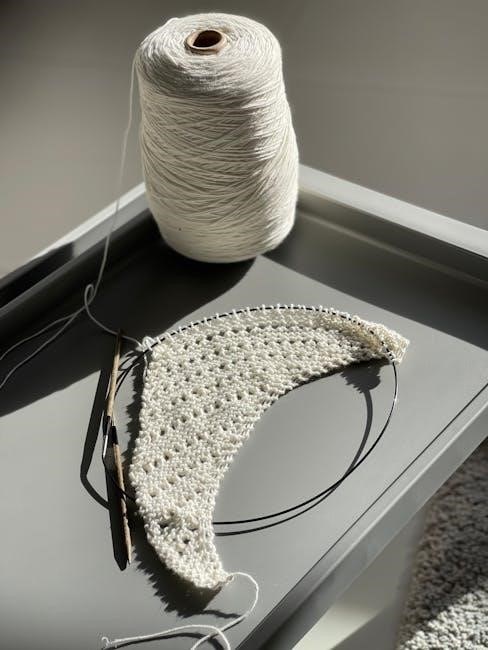
Step-by-Step Guide to Practicing Stitches
Start with basic stitches, choose the right hook and yarn, and follow patterns. Practice regularly, beginning with small projects to build confidence and skill in crochet.
5.1. Starting Your First Project
Starting your first crochet project is an exciting milestone. Begin by selecting a simple pattern from a crochet basic stitches PDF guide. Choose a project that uses stitches you’ve already practiced, such as a scarf or dishcloth. Gather your materials, including the recommended hook size and yarn weight. Create a slip knot on your hook and chain the required number of stitches. Focus on maintaining even tension and count your stitches regularly to ensure accuracy. Don’t be discouraged by small mistakes—frogging (ripping out) your work is a normal part of the learning process. Practice each stitch patiently, referring back to your PDF guide for clarification. Celebrate your progress, no matter how small, and remember, consistency is key to improving your skills.
5.2. Tips for Maintaining Consistency in Tension
Maintaining consistent tension is crucial for even crochet fabric. Start by choosing the right hook size, as specified in your crochet basic stitches PDF guide. Practice holding the yarn gently but firmly, avoiding pulling it too tightly or leaving it too loose. Use a swatch to gauge your tension and adjust your stitches accordingly. Keep your hands relaxed and avoid tightening the yarn while crocheting. Consistency improves with practice, so dedicate time to regular stitching. If you notice unevenness, try reworking the stitches or adjusting your yarn flow. Using the same yarn weight and fiber throughout your project also helps maintain uniformity. By focusing on steady, controlled movements, you’ll achieve professional-looking results.
5.3. Troubleshooting Common Mistakes
Common crochet mistakes include miscounting stitches, incorrect hook size, and inconsistent tension. Count stitches regularly to stay on track. If fabric seems too tight or loose, adjust tension using your crochet basic stitches PDF guide. Use stitch markers for pattern accuracy. Don’t hesitate to frog your work for significant errors—early fixes prevent larger issues. Keep a tapestry needle handy for weaving in ends neatly. Identifying and correcting mistakes is part of learning. Addressing errors promptly refines skills and yields professional results. Embrace mistakes as growth opportunities; practice leads to improvement.
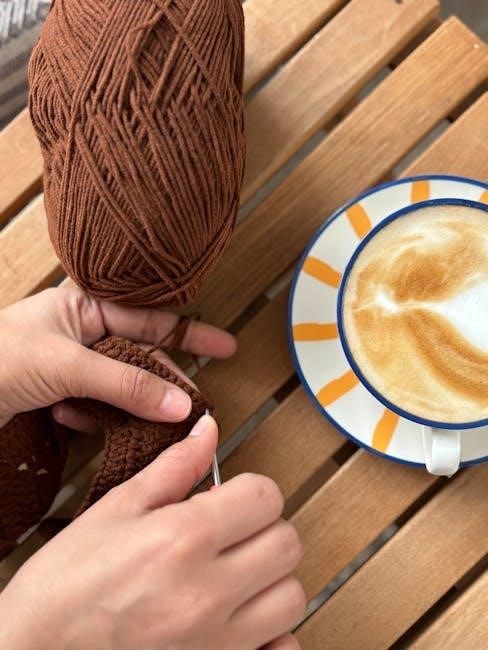
Projects for Beginners
Start with simple projects like scarves, dishcloths, and baby blankets. These builds confidence and skills using basic crochet stitches. Perfect for practice and quick results.
6.1. Simple Dishcloth
A simple dishcloth is an excellent project for beginners to practice basic crochet stitches. It requires minimal materials and time, making it a great confidence-builder. Use cotton yarn for durability and a size J (6.0mm) crochet hook. Start with a chain stitch, then work rows of single crochet (SC) or half-double crochet (HDC) stitches. This project helps master even tension and stitch consistency. Once completed, you’ll have a practical item for daily use. Customize the size by adjusting the chain length. This project is perfect for mastering the foundation of crochet before moving to more complex designs. It’s also a great way to familiarize yourself with yarn weights and hook sizes while creating something useful.
6.2. Beginner-Friendly Scarf
A beginner-friendly scarf is a wonderful way to practice basic crochet stitches while creating a stylish accessory. Start with a simple pattern using single crochet (SC) or half-double crochet (HDC) stitches. Choose a medium-weight yarn and a size J (6.0mm) hook for a soft, cozy texture. Begin with a foundation chain of about 60-70 stitches for a standard scarf length. Work row after row, maintaining consistent tension to ensure an even fabric. This project is ideal for mastering stitch repetition and edge management. Once completed, you’ll have a versatile accessory that can be customized with different colors or textures. It’s a great way to build confidence and familiarity with crochet rhythms before tackling more intricate designs.
6.3. Easy Baby Blanket
An easy baby blanket is a heartwarming project for beginners, perfect for practicing basic stitches like single crochet (SC) or half-double crochet (HDC). Use a soft, medium-weight yarn and a size H (5mm) hook for a cozy texture. Start with a foundation chain of 90-100 stitches for a standard baby blanket size. Work in rows, maintaining even tension to ensure a smooth fabric. This project is great for mastering stitch repetition and edge management. It’s also a thoughtful gift for newborns or expecting parents. Consider adding a simple border or texture for a personalized touch. The repetitive nature of the blanket makes it an excellent way to build muscle memory and confidence in your crochet skills while creating something truly special.
Advanced Resources for Learning
Explore advanced crochet guides, detailed stitch tutorials, and expert tips to refine your skills. Utilize online courses, stitch dictionaries, and crochet communities for continuous growth and inspiration.
7.1. Free Crochet Stitch PDF Guides
Access a wealth of free crochet stitch PDF guides online, perfect for mastering basic stitches. Websites like Moogly, The Spruce Crafts, and Crochet Geek offer comprehensive guides. These PDFs often include step-by-step instructions, photos, and diagrams for stitches like the chain, single crochet, and double crochet. They’re ideal for beginners and experienced crocheters alike. Many guides are printable, allowing you to practice anywhere. Search for “crochet basic stitches PDF” on platforms like Google or Pinterest to find these resources. They’re a great way to learn new techniques without cost. Whether you’re starting a project or refining your skills, these guides provide clear, concise instruction to help you succeed.
7.2. Paid Resources and Books
For a more in-depth learning experience, consider investing in paid crochet resources and books. These often provide detailed tutorials, high-quality photos, and comprehensive stitch libraries. Popular books like The Crochet Bible and Crochet 101 are excellent for mastering basic stitches. Paid PDF guides, available on platforms like Etsy or Amazon, offer structured lessons and printable charts. These resources are ideal for those who prefer organized, professional content. Many paid books also include patterns for beginner-friendly projects, helping you apply your skills. While free guides are helpful, paid resources offer more depth and clarity, making them a worthwhile investment for serious learners. They’re perfect for building a strong foundation in crochet basics and beyond.
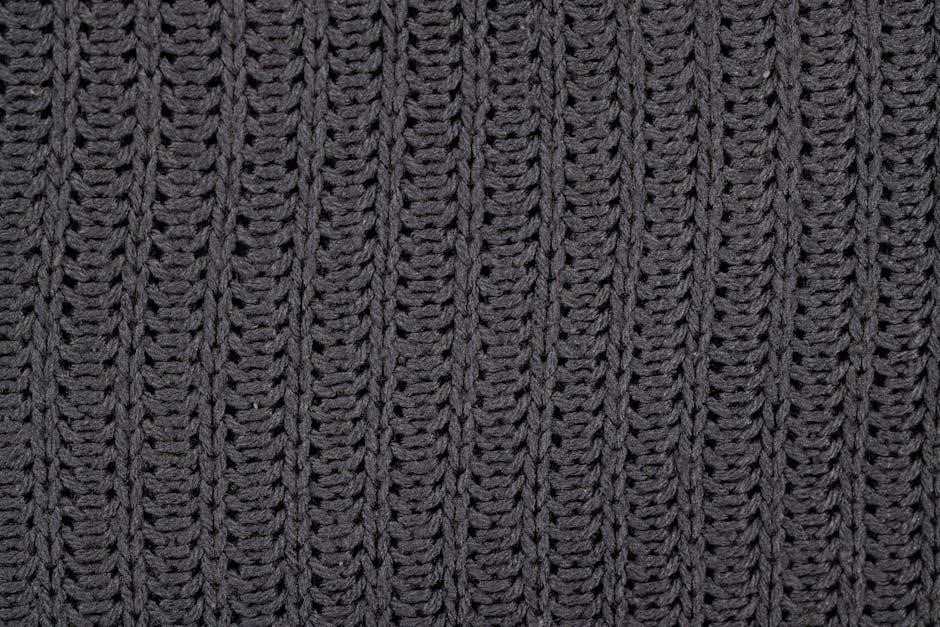
7.3. Online Tutorials and Videos
Online tutorials and videos are invaluable for mastering crochet basic stitches. Platforms like YouTube, Skillshare, and Craftsy offer a wealth of visual content. These resources provide step-by-step demonstrations, making it easier to understand complex stitches. Many tutorials are free, while others require a subscription or one-time purchase. Videos often include close-ups, slow-motion replays, and tips for common mistakes. They cater to different learning styles, allowing you to pause, rewind, and practice alongside the instructor. Paid platforms like Creativebug and Annie’s Online Classes offer structured courses with expert guidance. These resources complement PDF guides by adding a visual and interactive learning dimension. They’re perfect for visual learners seeking hands-on instruction and immediate feedback. Online tutorials are a great way to enhance your crochet skills and confidence.
Building a Strong Foundation
Mastering basic stitches is crucial for crochet success. Regular practice builds confidence and improves stitch consistency. A strong foundation ensures easier progression to complex patterns and techniques.
8.1. Importance of Practice
Regular practice is essential for mastering crochet basic stitches. Consistency helps develop muscle memory, ensuring stitches are even and tension remains balanced. Even short daily sessions can lead to significant improvement. Over time, practice builds confidence, enabling crocheters to tackle more complex patterns effortlessly.
- Start with short practice sessions to avoid frustration.
- Focus on one stitch at a time until it feels natural.
- Use practice swatches to gauge progress and adjust tension.
By dedicating time to practice, crocheters lay a solid foundation for advanced techniques and enjoy the creative process more fully.
8.2. Expanding Your Skill Set
Expanding your skill set in crochet involves exploring beyond basic stitches and techniques. Once comfortable with foundational stitches, crocheters can progress to more complex patterns and designs. This includes learning new stitches, understanding texture combinations, and experimenting with different yarn weights or colors. The crochet basic stitches PDF often serves as a gateway to intermediate techniques, offering clear instructions and visual guides to help bridge the gap.
- Start with intermediate stitches like the Treble Crochet or Chevron pattern.
- Experiment with combining stitches to create unique textures and designs.
- Explore advanced techniques such as granny squares or filet crochet.
Expanding your skills not only enhances creativity but also opens up possibilities for more intricate and personalized projects.
Mastery of crochet basic stitches opens endless creative possibilities. With the crochet basic stitches PDF as your guide, you can confidently progress to advanced projects.
9.1. Summary of Key Takeaways
Mastery of the chain stitch, single crochet, half-double crochet, double crochet, and slip stitch forms the foundation of crochet. These stitches are versatile and essential for any project. Always start with the right tools—a suitable hook and yarn—and practice maintaining consistent tension to ensure professional results. Troubleshooting common mistakes, like miscounting stitches, is crucial for success. Use the crochet basic stitches PDF as a handy reference to guide you through each stitch’s step-by-step instructions. Regular practice and patience will help you build confidence and improve your skills. Once comfortable with the basics, you can explore more complex patterns and projects, such as amigurumi, granny squares, or intricate afghans, to expand your creative horizons.
9.2. Encouragement to Continue Learning
Mastering the basic crochet stitches is a significant achievement, and you should be proud of the progress you’ve made. These foundational skills open the door to countless creative possibilities, from crafting cozy blankets to stylish clothing. Don’t hesitate to explore more complex patterns and techniques—each new stitch you learn will expand your artistic freedom. Join crochet communities, share your projects, and draw inspiration from others to stay motivated. Crochet is not just a hobby; it’s a relaxing and fulfilling way to express yourself creatively. Keep practicing, embrace challenges, and remember that every stitch brings you closer to creating something truly special. Happy crocheting!